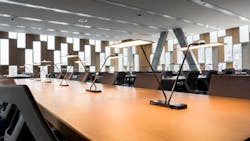LG Chem supplies OLED lighting to Seoul National University
Reading lights in the KwanJeong Library are now equipped with 1100 OLED SSL panels in one of the largest deployments of the planar technology globally.
LG Chem has announced that it supplied 1100 OLED light panels for reading lights used in Seoul National University’s new main library. The combination of energy efficiency, glare-free light, and the aesthetics of the reading lamps led to the selection of OLED technology despite the fact that it remains significantly more expensive than LED technology.
The university said that the sleek design of the reading lights matches the new library's "cutting-edge architecture." Still, the quality of the light was paramount in importance given the application. The library administration said the goal was to minimize eye fatigue and added, "OLED lighting is the best lighting option for the library’s study areas since it protects the eyes while offering a soothing and simple design, and we selected LG Chem’s lighting products because of the company’s technology leadership in the sector."
To date, OLED solid-state lighting (SSL) technology has trailed LED light sources in terms of efficacy and lifetime, while also remaining more expensive, as we covered in a feature on the topic. But OLEDs do offer efficiency advantages relative to legacy sources and in certain applications can be dramatic in function and style with the inherently-diffuse panel distribution. Moreover, prices are clearly coming down, as indicated by Acuity bringing products to the US retail market recently.
OLED performance has improved as well. The 320×110-mm panels used in the library lights deliver efficacy of 60 lm/W and are rated for 40,000 hours of life. Those specs would place the SSL products in the lower tier of LED-based products on the market, but in the SSL game for sure. Furthermore, you couldn’t easily achieve the sleek design of the lamps with LED technology.
LG Chem said the lamps deliver a maximum of 850 lx and include dimming controls than can smoothly take that level down to 300 lx. Legacy reading lights used in similar applications deliver 300–600 lx, according to the company.
"The adoption of OLED light panels at Seoul National University Library is a recognition of OLED lighting’s superiority," said Park Sung-Soo, vice president of the OLED light business at LG Chem. "LG Chem plans to commercially market in March the OLED reading lights installed at the Seoul National University Library, in addition to its Frame OLED lighting lamp, which is already being sold online. This is part of LG Chem’s efforts to create new consumer experiences with OLED lighting products."
We certainly expect more deployments of OLED technology this year. At LightFair International (LFI) last year, LG Chem said it was dropping prices to 33% of prior levels. Moreover, there have been numerous announcements in the industry indicating performance improvements. In October 2014, Philips Lighting announced brighter panels and cost reductions.

Maury Wright | Editor in Chief
Maury Wright is an electronics engineer turned technology journalist, who has focused specifically on the LED & Lighting industry for the past decade. Wright first wrote for LEDs Magazine as a contractor in 2010, and took over as Editor-in-Chief in 2012. He has broad experience in technology areas ranging from microprocessors to digital media to wireless networks that he gained over 30 years in the trade press. Wright has experience running global editorial operations, such as during his tenure as worldwide editorial director of EDN Magazine, and has been instrumental in launching publication websites going back to the earliest days of the Internet. Wright has won numerous industry awards, including multiple ASBPE national awards for B2B journalism excellence, and has received finalist recognition for LEDs Magazine in the FOLIO Eddie Awards. He received a BS in electrical engineering from Auburn University.






